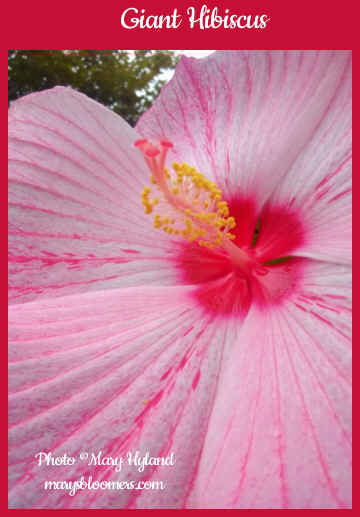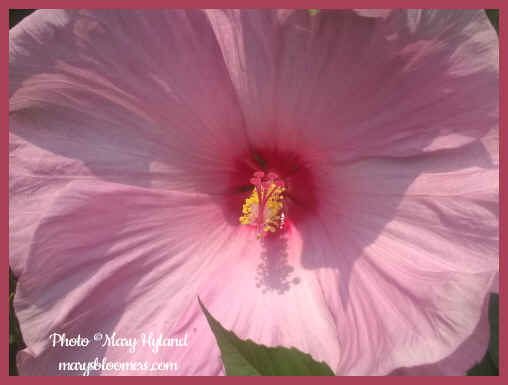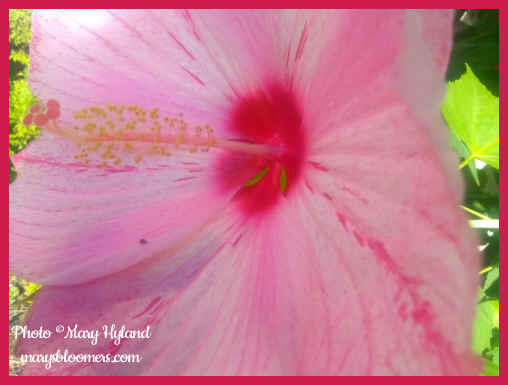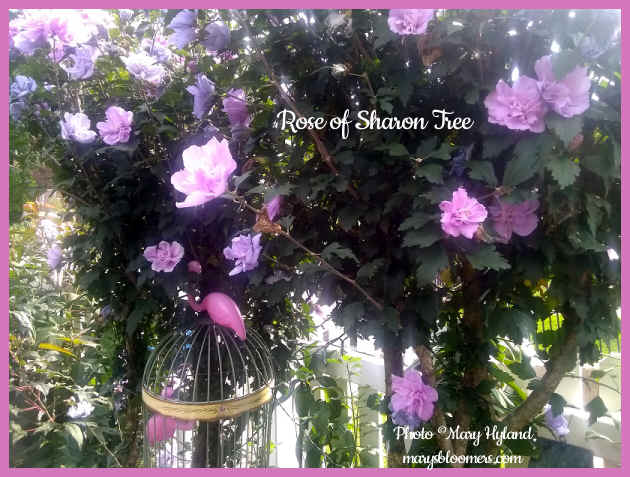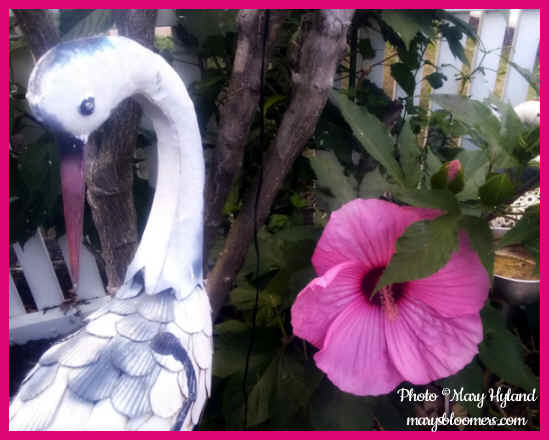 |
| Giant
Hibiscus is Rose of Sharon's giant cousin, with high-impact blooms that
average 10+ inches in diameter, the size of a large dinner plate. Both are members of the mallow family, a group of several hundred different plant species. Rose of Sharon is easy to train as a tree instead of shrub and you can squeeze in more stuff into that space because you're not using a lot of horizontal ground space. Vertical and single trunk is the way to go. You can't do that with Giant Hibiscus, though. They are big show-offs growing whatever way they want to. I trim them back a little through the growing season to keep them growing closer to the fence, and further back from my walkway. These beauties come in lots of shades and variegations of pinks, lavender, and less-common reds and whites. If you live in the northern states, do not mistake these cold hardy shrubs with the tropical hibiscus - or you'll be mourning the loss of them over the winter. I search for a hardy yellow variety. The tropicals come in a wider array of great colors, but you cannot grow them as perennials unless you live in the warmer, tropical states. Be aware of the zones stated on tags and in online catalogs, and choose only those that grow in your hardiness zone. I was misled once, and had the most spectacular hibiscus in the summer, only to lose them all over the winter. If you're not sure, you can search online by name of variety, or search a plant nursery's listings. Not all online catalogs and sellers are accurate. I grow both, and they're so easy to grow, you should try them. They are reliable and hardy bloomers. And the only care would be to tie or stake them..... because the gorgeous giants will reach 7ft tall. If you love the cottage garden look or have a picket or decorative privacy fence, these flowers are for you. Old-fashioned Rose of Sharon and bold Giant Hibiscus growing together along a fenced perimeter have that cottage and heirloom Grandmother's Garden look. It's also magical when seen from the street. Kids love to look at them, too.
Below are photos of the Hibiscus and Rose of Sharon plants showing off in my garden. Enjoy! For more photos of my hibiscus, click here---> How To Grow Giant Hibiscus and Rose of Sharon-->
How To Grow Rose of Sharon and Giant Hibiscus Both plants are hardy perennial shrubs and not much care is required, outside of pruning to shape or height and staking or tying the hibiscus. Both plants attract many types of pollinators, and the hibiscus attracts hummingbirds. Giant Hibiscus is just that - Giant. They die to the ground in winter, and are one of the last plants to push up stems in spring. Large, woody stems with a fibrous middle. Some of the stems on my plants are 2 inches in diameter. Staking will eventually be essential if they're not tied to a fence or leaning against a structure. While young, you'll start out using a 3 ft. garden stake. I use the steel stakes covered in green plastic stuff and pound them in. Starting the second year or so, you will be using 4-6 ft. stakes or tying them to fences and structures. They will easily reach 6-8 feet in a few seasons. These blooms are constant and prolific for about 3 months, when mature. Multiple flowers clustered on each stem of both Rose of Sharon and Hibiscus. The main stems are strong and wide when mature - be sure to allow about a foot of space between the plant and a fence. They won't harm the fence, but they'll be a little squished and the giant flowers would like some space to show off their flowers. They don't spread or interfere with structures. The 10-12 inch blooms are breathtaking, and I'm still astonished by their impact from the street or from my porch. Mine are grown alongside tall lilies, and near my Rose of Sharon trees. Enchanting cottage look and it reminds me of old school heirloom Grandmother Gardens.
Giant Hibiscus and Rose of Sharon, need no real care at all except the staking the giants and cutting them down in late fall, when they're done blooming. The giant satiny flowers look tropical, but the plants are hardy to zone 4. Tropical giant hibiscus are also available, but will not winter over. They are not appropriate for northern climates, so check the label. If it says "tropical", it is not winter hardy and would have to be planted every spring. Once these bloom, the buds bloom constantly in succession. The flowers actually live only a few days, but the other buds take over and you don't even notice it. You won't see stems without lots of buds waiting to open. Unlike Rose of Sharon, they die back to the ground each year, but achieve an amazing amount of growth over the summer. Expect these to bloom from July til killing frost. I do fertilie with fish emulsion once the stems appear, and then again in June. That's it. They are pest-free and drought-tolerant in my gardens. They attract pollinators of all types, and I sometimes get the hummingbirds feeding near dusk. These would be perfect for pollinator gardens and bird habitats, or front yard cottage gardens. Birds like the big, thick foliage as shelter. They are easily divided for new plants by slicing down through the base of the plant and pulling the plant apart. Even the tiniest bit of roots will take hold very quickly. They'll look pathetic when first planted, like many plants, but they get going with a watering every day for a week or so. Patience is key. You can populate an entire fenceline in a season through division in spring. The only downside is that they
make awful cut flowers. Very large and floppy blooms don't really have much stem
to cut, the stem is thick, and they're just too big to put in a vase. They're definitely an
outdoor flower show. It bothers me to have to cut them down late in fall
when the blooms are sparse, but there are still lots of buds on the plant. I don't want to be outside cutting them back in November, when it's
pretty cold here.
Growing Rose of Sharon Trees Rose of Sharon Trees look like dwarf ornamental trees as they matue, and it's easy to do it yourself. These are perfect in the garden when planted along with their giant free-wheeling hibiscus cousins. I placed 5 a few feet in front of the giant hibiscus groupings, which are up against a fence. They begin to bloom close to the same time as the giants for a while for quite a display. If you're landscaping in reverse with the plants in front of your fence (mine are on the inside), plant a group of hibiscus along the fence with a rose of sharon tree wherever you like in front of them, planting the trees about 6 ft. apart. I promise you a spectacular show. Rose of Sharon trees do not spread, because you're constantly dwarfing them with pruning. I plant a few very close to each other and just shape them. You can grow Rose of Sharon Trees easily in big pots for your patio, terrace or balcony, as well as potted in the garden. They come through our zone 6 winters beautifully. I place pots in different areas to encourage the pollinators where i want them to get to work pollinating my fruit and ornamental trees. These are a multi-stemmed shrub that can grow to be 8 to 12 feet tall, and 6 to 10 feet wide, they can be planted 10 to 12 feet apart to make a hedge. If you prefer a standard tree-shape, the extra stems can be carefully pruned out to give it that appearance. Since they flower on new wood do any pruning early in the season to give the plant a chance to recover and regrow new branches.
They require full sun to produce the most blossoms, but will still bloom in light shade. They prefer moist, well-drained soil and love the heat. Deer and rabbits leave them alone, but butterflies and bees are addicted to them. Destructive bugs tend to ignore them, except if you have an invasion of Japanese Beetles in your area. Then you'd want to hand a few Japanese Beetle traps in your yard. I have a bird habitat, so I don't see many pests. Note: Rose of Sharon is considered an invasive in some parts of the country. To avoid excessive stray seedlings, look for a sterile cultivar that doesn’t produce any seeds, orr plant them in big pretty pots, instead of in-ground. The shrubs i planted in-ground do put out suckers and i do diligently pull/dig/chop them out. I train my Rose of Sharon shrubs into dwarf trees. I cut the side shoots below what i pick as it's future main stem on a regular basis, and try to keep up with the suckers at the base of the plant. The trees are lovely, and take up only a few feet horizontally - vertical is the way to go to save horizontal and ground space. They grow new stems constantly at the top, and i prune mine back a foot twice per season. Once in spring, i'll prune about a foot, (my personal choice measurement for height and shaping) so that the pruning doesn't interfere with summer flower production, and then again after they bloom with a really hard pruning to reduce the height before they go dormant. If you cut back enough before dormancy, you can eliminate the spring height pruning. They take to the pruning very well with no ill-effects.
If you are going to try training into trees, strip off stems and leaves diligently below what will eventually be the crown of your tree. You can easily pinch off young growth. They grow in a vase shape - V-shaped - so you'll want to cut some new branch growth to limit their width and have a tree that is steady in winds and rain. When you see a branch loaded with heavy leaves and flowers bending or breaking from the weight of a downpour, you'll know which ones should be on your pruning list. That's how i figured it out. My trees average 8-10 ft with pruning and flower heavily.
For more photos of my hibiscus garden, click here--->
Quick Links Content, graphics,
photos and design ©2020 marysbloomers.com |






